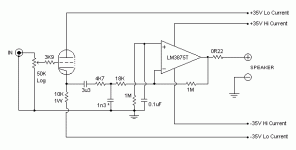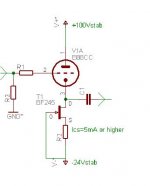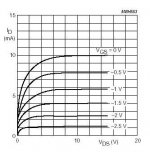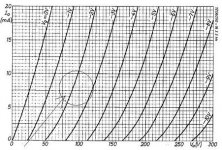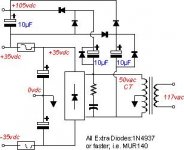I started this thread in the chip amp section, asking for help designing a constant current source for Joe Rasmussen's tube gainclone project. Maybe there will be more interest here.
I read this article by Nelson Pass which describes some current source designs. I was thinking about using the mosfet version, with a 1N936 temperature compensated zener (since I happen to have some on hand).
Joe's circuit is attached for reference.
Any thoughts?
I read this article by Nelson Pass which describes some current source designs. I was thinking about using the mosfet version, with a 1N936 temperature compensated zener (since I happen to have some on hand).
Joe's circuit is attached for reference.
Any thoughts?

Attachments
moamps said:Hi,
why in solid state forum?🙂
Isn't Tubes better ?
I put it in solid state because I was looking for a solid state current source. But I guess you're right; the tube forum probably would have been a better choice. Maybe I should have this thread moved.
A (probably stupid) question about your ccs suggestion: Does it depend on regulated supplies, since it has no voltage reference?
Okay, it was a stupid question, since this is a JFET ccs, so it doesn't need a voltage reference. I guess this is the quietest way to go. I notice that you recommend a higher B+ voltage, too.
Sparhawk said:Okay, it was a stupid question, since this is a JFET ccs, so it doesn't need a voltage reference. I guess this is the quietest way to go. I notice that you recommend a higher B+ voltage, too.
Hi,
Only 35V for +B voltage is minimum, IMHO. For my taste, Va=ca +100V, and Ia=5-8mA are optimum values for this application.
Your Q are OK, don't worry.
(I have one stupid Q; mod's, anyone, help; how can I place more than one pic in one post??)
Regards
Attachments
Maybe I'll try a higher B+ voltage, then, assuming I can find an appropriate transformer.
You can use the IMG tag to post multiple pics, but in that case you're not actually uploading the pics with the post, so they must be accessible via a URL (ie, on a web server).
moamps said:(I have one stupid Q; mod's, anyone, help; how can I place more than one pic in one post??)
You can use the IMG tag to post multiple pics, but in that case you're not actually uploading the pics with the post, so they must be accessible via a URL (ie, on a web server).
moamps said:(I have one stupid Q; mod's, anyone, help; how can I place more than one pic in one post??)
not stupid... you can only attach a single picture, but if the picture is already out in webspace you can link to it and show multiple pics in a single post.
dave
Hi,
thank you both for answers about posting pics. Here is one interesting PS schematic (voltage tripler) for getting high +B from 24Vac ct source. By adding -24V regulator (7924 or so), whole PS for HGC-CS can be implemented easily (just a thought).
You can find out more at: www.tubecad.com/march2001/page24.html
Regards
thank you both for answers about posting pics. Here is one interesting PS schematic (voltage tripler) for getting high +B from 24Vac ct source. By adding -24V regulator (7924 or so), whole PS for HGC-CS can be implemented easily (just a thought).
You can find out more at: www.tubecad.com/march2001/page24.html
Regards
Attachments
Hi,
Moamps,
Would R2 be necessary? Or did you put it there to protect the Fet against turn-on transients?
From looking at the BF245 datasheet it seems to me the BF245B is the better candidate for the job or I'm I mistaken?
Another silly question showing my ignorance of all things solid state: are yuo regulating the -24VDC supply with something like an 7924 or similar?
EDIT: I just noticed you answered the last Q already, thks.
TIA,😉
Moamps,
Would R2 be necessary? Or did you put it there to protect the Fet against turn-on transients?
From looking at the BF245 datasheet it seems to me the BF245B is the better candidate for the job or I'm I mistaken?
Another silly question showing my ignorance of all things solid state: are yuo regulating the -24VDC supply with something like an 7924 or similar?
EDIT: I just noticed you answered the last Q already, thks.
TIA,😉
fdegrove said:Would R2 be necessary? Or did you put it there to protect the Fet against turn-on transients?
R2 sets the current for the ccs, doesn't it?
fdegrove said:Hi,
Would R2 be necessary? Or did you put it there to protect the Fet against turn-on transients?
From looking at the BF245 datasheet it seems to me the BF245B is the better candidate for the job or I'm I mistaken?
Hi,
With R2 you can set Id (Ia), and noise figure is slightly better; without R2, Id is determinate with particular FET characteristic.
We can use ordinary 7924 here.
I didn't try in practice this circuit (and PS) yet. I will, but haven't time in this moment. I agree that BF245B (and C) is better solution; I use them just for example.
We must (altogether) spend more time on this idea (theoretically and practically).🙂
Regards
Hi,
Yep...my penny dropped a little too late...
I think it will work as shown- the CF part anyway-, I have a similar circuit to yours but with the CCS in the anode load using a BF244A at 1mA.
Thanks guys,😉
R2 sets the current for the ccs, doesn't it?
Yep...my penny dropped a little too late...
We must (altogether) spend more time on this idea (theoretically and practically).
I think it will work as shown- the CF part anyway-, I have a similar circuit to yours but with the CCS in the anode load using a BF244A at 1mA.
Thanks guys,😉
moamps said:
Thanks for the link; very interesting.

(note: it's missing .html on the end.)
Go to http://home.pacifier.com/~gpimm/ and look in 'schematics' and 'CCS measurements' for a whole heap of excellent CCS, and some lucid explanations of how and why.
This one also works quite nicely if you can find some DN2450's.
http://home.zonnet.nl/horneman/hoofd.htm
In most cases the only reason I can see why a tube CCS would be better is marketing.
This one also works quite nicely if you can find some DN2450's.
http://home.zonnet.nl/horneman/hoofd.htm
In most cases the only reason I can see why a tube CCS would be better is marketing.
Hi,
Ouch...
Cheers,😉
In most cases the only reason I can see why a tube CCS would be better is marketing.
Ouch...
Cheers,😉
Brett,
Thanks for the links. The DN2540 looks interesting. Looks similar to a JFET ccs, but with much higher voltage & current ratings.
Thanks for the links. The DN2540 looks interesting. Looks similar to a JFET ccs, but with much higher voltage & current ratings.
Brett said:In most cases the only reason I can see why a tube CCS would be better is marketing.
Although semiconductor CCS can be made to be very good, and they're far less expensive on HT voltage than valves, a valve can often achieve lower output capacitance.
Hi,
Add to that that I have an almost instinctive distrust for semiconductors floating at highish voltages....
Hell, they don't even glow...
Let's face it, if anything is going to break down in a valved product it's 9/10 a zener, a reg or anything else solid state that per definition has it's reference removed by the manufacturer or at best is merely obsolete...which means yesterday nowadays.🙁
Is there anything you can do with transistors you can't do with tubes?
Not that much, I'd say...
Oh, they do call me "Le Puriste" in my country for some obscure reason....
Cheers,😉
and they're far less expensive on HT voltage than valves, a valve can often achieve lower output capacitance.
Add to that that I have an almost instinctive distrust for semiconductors floating at highish voltages....
Hell, they don't even glow...
Let's face it, if anything is going to break down in a valved product it's 9/10 a zener, a reg or anything else solid state that per definition has it's reference removed by the manufacturer or at best is merely obsolete...which means yesterday nowadays.🙁
Is there anything you can do with transistors you can't do with tubes?
Not that much, I'd say...
Oh, they do call me "Le Puriste" in my country for some obscure reason....

Cheers,😉
- Status
- Not open for further replies.
- Home
- Amplifiers
- Tubes / Valves
- Help with ccs
